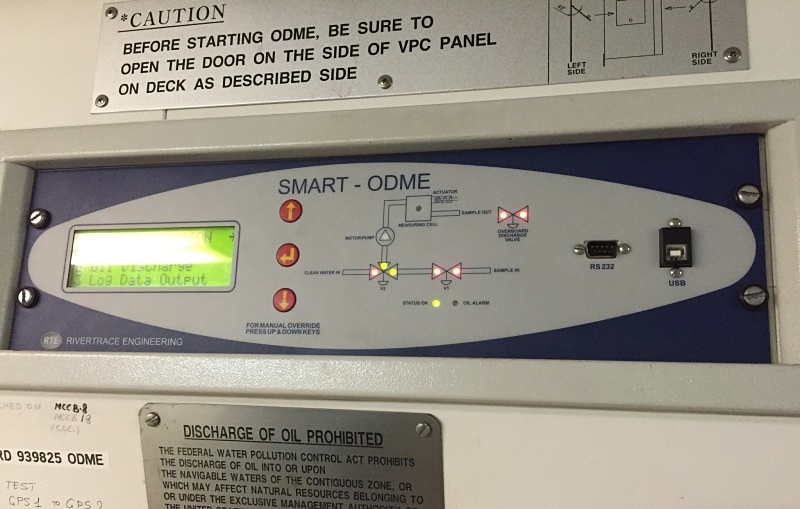Before we come to ODMCS tests, it is better to first do a recap on the requirements of ODMCS. ODMCS (Oil discharge monitoring control system), sometimes also called ODME (Oil discharge monitoring equipment) is an equipment required under Marpol Annex 1 and is required to monitor discharge of oily mixture from cargo tanks of oil tankers.
The Marpol requires following for discharging oily Mixture
- The tanker should not be in special area
- The tanker should be Enroute
- The tanker must be more than 50 Nautical miles from the nearest land
- The instantaneous rate of discharge should not exceed 30 litres per Nautical mile
- The total quantity of oil discharged should not exceed 1/30000 of the total quantity of cargo of which the residues formed a part.
- The tanker must have an approved ODMCS and it should be operational
ODMCS is installed to ensure compliance with the requirements no 4 and 5 and so the testing of ODMCS should be based upon to find if
- The ODMCS would actually stop if “instantaneous rate of discharge” exceeds 30 litres per nautical mile.
- The ODMCS should stop when total oil discharged has reached the allowed limits as per point 5 above.
It is general practice among many seafarers to test the ODMCS for only IRD, but as I have pointed out, the regulation require the ODMCS to stop when total oil discharged limit exceeds and thus this is an equally important test too.
Test for Instantaneous rate of Discharge
The formula for IRD is
IRD (in litres/Nautical mile)= Oil content(ppm) x Flow rate (m3/hr) / Speed (Knots) x 1000
For ODMCS discharge valve to open, the IRD should be less than 30 L/NM and we just play with oil content, flow rate and speed (enter these values manually) to get the IRD to say 29.8 L/NM and discharge valve should open. We then increase the oil content a bit to make the IRD 30.1 L/NM to see if the discharge valve closes. Pretty simple. However this is just the simulation test which just tells us that the computing unit of ODMCS is working alright.
It does not tell us if in actual operation the oil content meter and flow meter will give correct reading of oil content and sample flow respectively. For this reason, the oil majors require the annual calibration of oil content meter and flow meter by an external competent company. Master and ship staff should ensure that such annual test has been carried out and certificate is available onboard.
It is also important in actual operation of ODMCS that sample is drawn from the discharge line and fed to oil content meter so that it can measure the oil content in the oily water. This sample is drawn and circulated through oil content meter by Sample pump. This makes the sample pump extremely important for the functioning of ODMCS and hence sample pump should be checked monthly for its free movement by rotating with hand
Test for Total quantity Discharged
First of all let us understand the rationale behind this requirement. The first requirement was that while the ship is moving, you can discharge 30 litres of oil contained in the oily water provided this 30 litre is spread over one nautical mile. If the second requirement is not there, one could keep on diluting the oily mixture to make sure IRD is always less than 30 L/NM and pump out entire tank content. This requirement limits the total oil that a ship can discharge irrespective of complying with the first requirement.
So if the vessel was carrying 45000 m3 of oil cargo and oily mixture are formed from washing or ballasting these tanks, the total oil that can be discharge through ODMCS is 45000/30000 which is 1.5 m3 or 1500 Ltrs. This figure need to be entered in the ODMCS before actual run of ODMCS.
Now how to test if after achieving this limit the ODMCS will shut the discharge valve and open re-circulation valve. Test is again pretty simple, set a lower value and run the ODMCS in simulation mode with IRD say around 29 L/NM. You would see the Total oil discharged reading go up. When you reach the set value of total oil discharged, the ODMCS should shut the discharge valve.
Even though there may be some other small tests like power failure test etc. Checking and testing the ODMCS and associated components as mentioned above would most likely ensure that your ODMCS would be ready when you require it.
Share this:

About Capt Rajeev Jassal
Capt. Rajeev Jassal has sailed for over 24 years mainly on crude oil, product and chemical tankers. He holds MBA in shipping & Logistics degree from London. He has done extensive research on quantitatively measuring Safety culture onboard and safety climate ashore which he believes is the most important element for safer shipping.
Search Blog
More things to do on myseatime

MySeaTime Blogs
Learn the difficult concepts of sailing described in a easy and story-telling way. These detailed and well researched articles provides value reading for all ranks.

Seafarers Question Answers
Ask or answer a question on this forum. Knowledge dies if it remains in our head. Share your knowledge by writing answers to the question

MySeaTime Podcast
This podcast on the maritime matters will provide value to the listeners. Short, crisp and full of value. Stay tuned for this section.


0 Comments
Leave Comment